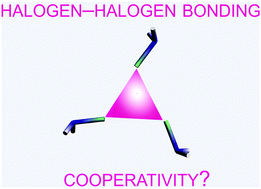Halogen-bonded haloamine trimers – modelling the X3 synthon†
Abstract
Halogen–halogen bonded haloamine trimers serve as model systems for the X3 synthon present in numerous crystal structures and in two-dimensional self-assembled nanoarchitectures. Halogen bonds forming the synthon are often considered to display cooperativity. Synergy effects were previously found for halogen–halogen bonded bromoamine and iodoamine tetramers. In the present study comparison between haloamine cyclic trimers and tetramers is made. The cooperativity occurring in bromoamine and iodoamine clusters is significantly weaker in the case of the trimers. The present study demonstrates that the bromoamine and iodoamine trimers display weaker cooperativity due to a smaller number of synergy components in comparison to the corresponding tetramers of stronger cooperativity. Moreover, the halogen–halogen interactions in bromoamine and iodoamine dimers with the geometries of the corresponding trimers and tetramers are examined using energy decomposition analysis methods (supermolecular, canonical EDA and SAPT) and the Kohn–Sham molecular orbital model. The results of the analysis indicate that although the interaction energy values for the dimers of the different spatial arrangement are very close to each other, their origin is substantially different. For pairs with the geometry of the trimers orbital interactions and electrostatic attraction are both weaker than for the corresponding dimers with the geometry of the tetramers. This is especially important because both donor–acceptor interactions and electrostatic attraction were previously proven to be responsible for cooperative effects occurring in the bromoamine and iodoamine tetramers.



 Please wait while we load your content...
Please wait while we load your content...